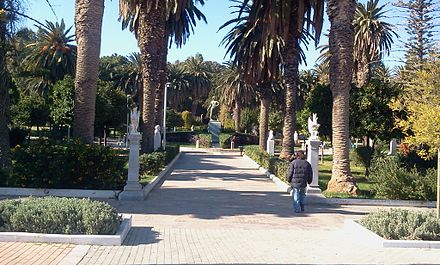Chios (town) - Greek town on the homonymous island
 Chios (town) is the biggest town on the island of Chios.
Chios (town) is the biggest town on the island of Chios.
Understand
The new city was built with neoclassical buildings, with clear influences from the nearby Smyrna. The modern city has features of any modern city, but retains some features from its past. Among them, the old mosque with a tall minaret, which now houses the Byzantine Museum, the neoclassical High School of Chios (formerly School of Chios, which operated in the period 1792-1822), the imposing neoclassical Korai Library, etc.
Orientation
Vounaki Square 📍, - during the Ottoman occupation it was where the executions have been done, and it was called by the Turks "the sword of the Square" (Kilitz-meintan) - it's where are the administrative buildings of the Regional Unit of Chios, the Town Hall, the Ottoman Mosque (Mosque Metzitie) which houses the Byzantine Museum Chios and the great and cool Public Garden. Is a region that combines the present with the past of the region. Near the square, there are remarkable buildings that survived the Ottoman era on the island, the Bairakli Mosque, Osmanie Mosque and Ottoman fountains.
From the center of the square, the Kennedy pathway leads to the official portal of the medieval castle of Chios. The construction of the fortress dates back to the late 10th century and especially the 11th century in place around the ancient city and in direct relation to the port. The castle has been continuously inhabited since the time it was built until now, has the characteristics of the old residential fortress, i.e. narrow streets, many ruins and buildings of various eras.
In the south of the square extends the main street of the city, Aplotaria 📍. The road passes through the heart of the old town, holding today the largest part of commercial traffic, with many shops that make a worthwhile purchase. In Aplotaria are most buildings of the 19th and early 20th century, old mansions buildings. Towards the end of Aplotarias to the east, a road leads to the Secondary School which was founded in 1792, the Cathedral and the Library of Korai. In the southern city districts that were inhabited in the 20th century and since then include the city's expansion trends. This area is the Archaeological Museum, Aegean University, the central stadium of the city, and the Maritime Museum.
Kampos 📍, (meaning plain in Greek) is the area south of the airport. Since the 13th century Genoese nobility, consisted of a privileged group of laymen, such the 'Argenti', owned landed properties in the island of Chios. They successfully transformed Kampos into extensive orchards. They also imported black and white mulberry from Middle East in the hope that it would be useful in the cultivation of silkworms. Their mansions with arched doors and windows and painted ceilings still stand in Kampos. Some of the estates have been transformed into hotels, giving the guests the chance to experience by first hand the neglected history of Kampos.
Get in
Get around



See
- Archaeological Museum, 38.3652°, 26.1393°. 2015/09/11
- Genoese Castle, 38.374°, 26.137°. Its strategic location is great as it is located at the narrowest passage in the northern Aegean. Therefore it was developed very early. Excavations have revealed findings that indicate a large thriving city, as mentioned by Herodotus. Was an Ionic city with theater, huge port for 80 ships and a large temple dedicated to the goddess Athena. 2015/09/11
- Korais Library, Philippou Argenti St, 38.367807°, 26.136762°, +30 2271 044246. it has 135,000 volumes and upstairs has a Gallery and a Folklore Museum 2015/09/11
- Citrus Museum (Argenti 9-11, Kampos), 38.323366°, 26.124704°, +30 2271 031513. 10AM–9PM. 2016-02-17
- Chios Byzantine Museum (Mecidiye Mosque), 38.3705°, 26.1363°. 2017-08-24
- Osmaniye Mosque, 38.374585°, 26.129944°. 2017-08-24
- Chios Medical Museum, 38.366613°, 26.141024°. 2017-08-24
- Bayrakli Mosque, 38.372866°, 26.136117°. 2017-08-28
- Turkish Cemetery, 38.372425°, 26.13602°. 2017-08-28
- Turkish Cemetery, 38.372425°, 26.13602°. 2017-08-28
- Chios Maritime Museum, 38.367074°, 26.133869°. 2017-08-28
Do
Buy
Eat
- Vradipus (Βραδύπους), Agiou Georgiou Frouriou 18, Chios 821 00, Greece, 38.37321°, 26.13667°. 13:00-02:00 (Closed on Mondays). Located in the Castle of Chios, this Greek traditional fusion restaurant is a must-eat in Chios. Affordable prices. 2023-02-04
Drink
Sleep
Splurge
- Chios Chandris Hotel, 2, Evgenias Chandri Street, 38.3670°, 26.1431°, +30 22710 44401-3. A 4 star hotel built in 1970 and renovated in 2000 2016-02-17
- Argentikon Luxury Suites, Argenti-Giazou Street (Kampos Region, near Citrus Museum), 38.323809°, 26.125489°, +30 22710 33111. The former country estate built in 1550 by the Argenti family from Genoa, now a five star hotel, fits for distinguished and most demanding guests, as stated in their site. 2016-02-17
Connect
Go next
Chios
chioscity.grPostal code:82100Date Time:Please wait...Timezone:Europe/AthensPopulation:27,015Coordinates:38.37, 26.14
Chios
2nd-order administrative division
North Aegean Region
Primary administrative division